Resonance with Names
Years ago, a friend who owned a video game company called me and said, "Dave, I have a problem. We've made this great fantasy videogame, but we don't have a name for our hero. I've been going over names with my staff for days, and we're stuck. How do you name a fantasy character?"
"That's easy," I said. "You take two words that come to mind to describe that character, then put them together, and consider their sounds to make sure that they resonate properly."
I then asked him to describe the character in five or six words, and I spat out a name. My friend was silent for a moment, and then said, "That's perfect. That's perfect! We've been beating our heads against a wall for weeks, and you come up with the name in ten seconds. Tell me again how you do that?"
I can't even recall the name, but I met the friend a few weeks ago, and he reminded me of the incident. So I'll try to make this process a little clearer.
A classic example of this might be seen in George Lucas's use of the name Darth Vader. "Darth" is probably a contraction of "dark" and "death," or it might be a modification of "dearth." "Vader" could be a truncation of "invader," or it could simply be Dutch (vader) for "father." Hence, I'm fairly certain that it is inspired by the words "dark," "death," "invader" and "father." But by happy coincidence, it resonates with other dire-sounding words as well.
Similarly, Tolkien used these techniques in creating names. Some of his names are easily untangled. Treebeard is an ancient tree with a lichen-like beard. Mount Doom doesn't need to be untangled at all. Mordor, the name of the evil kingdom where Sauron dwells, sounds like "murder," but of course "more" and "door," the two words that make up the name, suggest that by entering this place, you might be walking through a door into murder.
However, Tolkien complicates what Lucas did by using names that often have foreign roots. Remember that Tolkien was a philologist, one of the world's foremost authorities on the origins of words with Germanic roots. He was very familiar with old German, Norse, Danish, English, and so on.
Take Gandalf Greyhame. The name "Gandalf" is an Old Norse name taken from a list of dwarves from folklore. The word Gandalf is a contraction of gandr (wand) and alf (elf). Hence his name literally means "elf with a wand." But you don't have to speak Old Norse for it to resonate. In English it sounds like a contraction of grand and elf. So whether you are talking Old Norse or English, the sound of the name resonates. Greyhame is a bit easier. Hame is an Old Dutch word for "home," and is also the root for the word "hamlet." Thus, the name itself sounds like "gray home," (much like the Gray Havens that the Elves in The Lord of the Rings are fleeing to for refuge). Tolkien says that the word translates into one of his mythical languages as "gray mantle"—which is an odd mistake for Tolkien to make. Having words in two separate languages that are spoken as "gray" and that mean "gray" sounds odd. It just doesn't happen unless those languages are linked by common roots. Tolkien once lamented that the name Gandalf was concocted unwisely in an hour with little thought, but it's still quite serviceable as a name.
Here's another name: Gollum. Gollum is a hobbit-like character who was magically turned by sorcerous power into a monster. His name is obviously morphed from the word "golem," which in Jewish folklore was a creature made from inanimate materials—such as twigs and string—so that it was magically transformed into a living servant. In many ways, Gollum is a golem—a monster given long life so that he can serve his evil master.
What about the name Sauron? Once again, Tolkien says that it has a meaning in a foreign tongue (the elvish language Quenya) and that it means "abhorred." But the name has entirely different roots. In Greek, the word saur means "lizard," as in "dino-saur." The suffix on in "Sauron" means "the first." Hence, Sauron's name translated from Greek is "The First Lizard," or perhaps more appropriately, "The Great Lizard" or even "The Lizard King." Tolkien would have known this. So Sauron is, in essence, the king of all cold-hearted creatures, the ultimate heartless killer.
Interestingly, Tolkien seemed to be keyed into creating names as a way of developing his characters.
I've seen poets—Leslie Norris, Shakespeare, and Tennyson—who seem to be led by sounds to create stories. An internal rhyme may suggest a couple of words, which then lead to a sentence. The sentence gives rise to a paragraph in which an interesting string of words creates a whole new image that must be elaborated upon—which leads to a new twist in the plot of the tale.
So for some authors, sound leads to story. For Tolkien, a name like Gollum suggests both a backstory and an ending.
But Tolkien was more keyed into his characterization by resonance than most. For example, early in The Lord of the Rings he had a character that Frodo met at an inn—a dangerous character nicknamed Trotter because of the clattering sound that his wooden shoes made when he walked over cobblestones. But editors warned Tolkien that the character sounded silly.
So Tolkien turned Trotter into Strider—a character who became rather regal. "Strider" of course has its roots in "strident," which suggests that this is not only a person who travels, but one who does so with a deadly purpose. Later, even that name did not suffice. Strider was in fact a man on a mission to reestablish himself as a rightful king—so Tolkien lets us know that Strider's real name was "Aragorn," a name that has interesting resonance. (Aragon is the name of a royal family in Spain, which suggested a whole plot line)
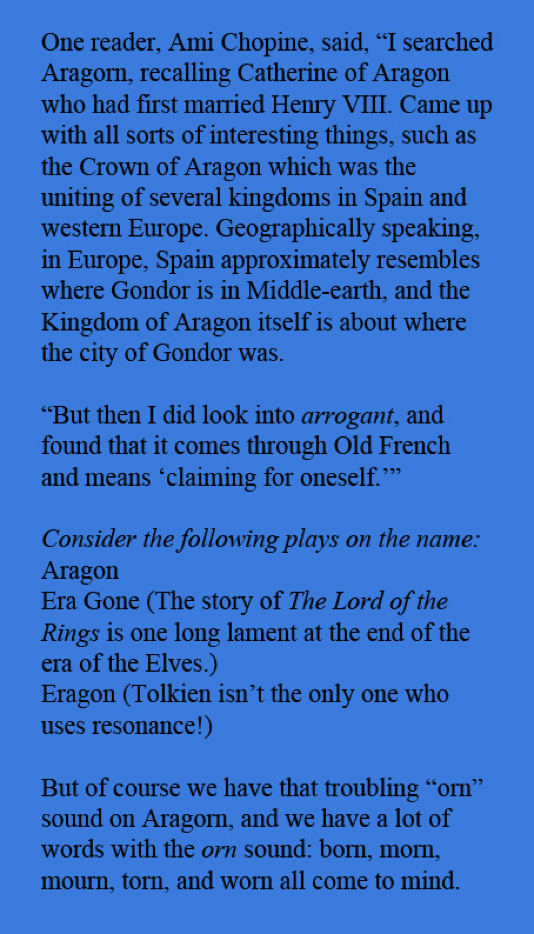
Often, Tolkien's character or place names give hints to his societies. For example, the Dwarves often have names taken from Old Norse. Tolkien names one Dwarf Thorin Oakenshield—the name of an early Norse conqueror who settled in England.
In other words, the Dwarves symbolically represent the Norse in English history. The Elves, I suspect, have a language drawn from Gaelic, and represent the older inhabitants of England. Tolkien's Men represent the chivalric knights of the middle ages. Older creatures—ghosts, ancient woodsmen, and even trees, all serve as symbols of the land's past. In short, all of his ancient peoples are fighting to combat the future. But what future are they combating? Sauron's name is taken from Latin. I suspect that Tolkien was writing a tale in which all of England's past is fighting a New Rome, the next world order.
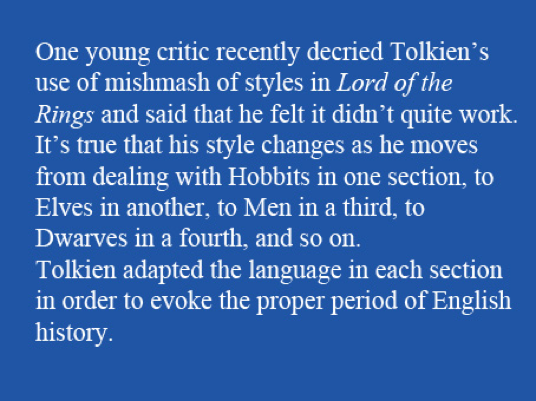
Among Elves, the el is a common suffix or prefix—Elrond, Tinuviel. El of course is an old Hebrew word for "god," and thus his elves are given names that associate them with immortals. Tolkien once wrote a treatise on how the name "elf" has its roots in the Hebrew word "angel." The word "angel" is a compound of "messenger" and "god." The word "elf" literally has the same meaning. Hence, when Tolkien wrote of elves, he did not make them the little gnomish people that we associate with Santa, but instead made them creatures of light with almost divine powers, a little higher than us mere mortals.
So here is what you need to recognize about Tolkien's use of resonance in naming: on a linguistic level, he is looking at the roots of words and realizing how they affect his readers on a subconscious level. This way, when you read about a character named Elrond or Gandalf or Strider or Gollum or Sauron, you may know very little about that character, and yet somehow there is a sense of "rightness" about that character, a sense that he is more than he seems.
I discussed how Tolkien's The Lord of the Rings resonated with Wagner's operas. It also resonated with the poetry of Yeats and Tennyson along with the work of Shakespeare.
For example, in Macbeth, Malcom's soldiers disguise themselves with boughs in Birnam Wood and then march to Dunsinane hill. This part of the play inspired Tolkien to create his Ents—trees that actually move. In a letter he wrote to poet W.H. Auden, Tolkien said that after studying Macbeth he "longed" to create trees that really marched to war.
Also in the play, the witches prophesy that no man born of a woman can overpower Macbeth, but because Macduff was born by C-section, he manages to defeat Macbeth. This resonates with a similar situation in The Lord of the Rings. The Elf Glorfindel prophesies that the Witch-King cannot fall by a man, but Eowyn, a woman, slays the Witch-King.
Of course, Tolkien wasn't just trying to resonate with Shakespeare. He drew on other sources, some of them that were quite modern. Tolkien wrote The Lord of the Rings over a period of about 13 years, and he writes that in 1939 he ground to a halt at Balin's tomb. He says that it was "over a year later, in 1941 that I moved on . . ." Now, Fantasia was released in 1940, and I doubt that you will have to think about it long before you recognize the resemblance that the Balrog in The Lord of the Rings has to the demon from "Night on Bald Mountain" in Fantasia. It wasn't until Tolkien incorporated the demon Chernabog and wrote of the death of Gandalf that he was able to move forward. Here is Chernabog in picture form, followed by the Balrog.

When I first read about the Balrog as a teen, I found it easy to envision him. Why? Because I'd seen him before. Even though I didn't make a conscious connection, I was familiar with the balrog from childhood, just as other images from the novels came with similar force.
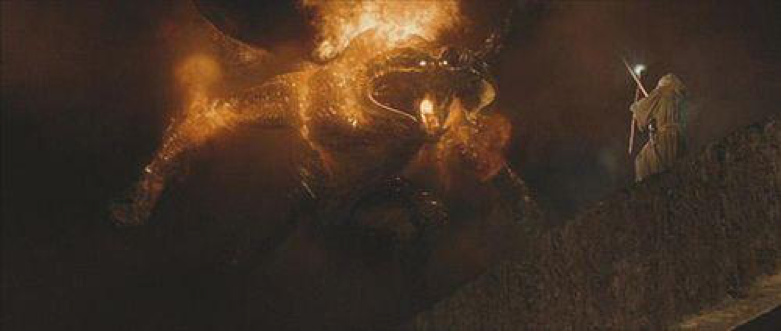
Tolkien drew plenty of inspiration from Pre-Raphaelite artists. Notice the similarities between their work and his Lord of the Rings.
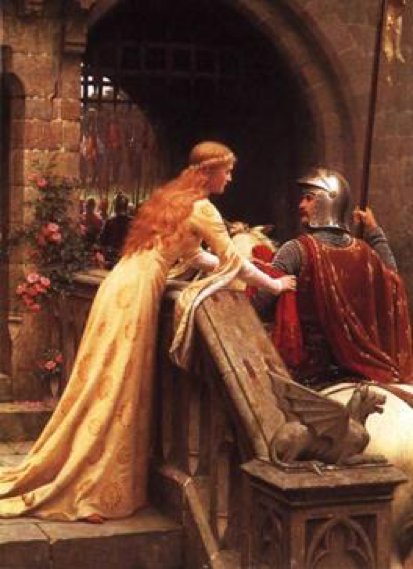
"Godspeed" by Edmund Blair Leighton
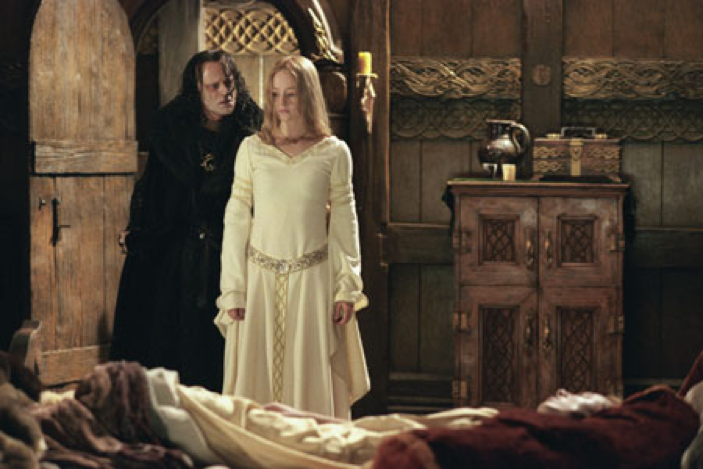
Note the borrowed dress design used in The Lord of the Rings.

"Ophelia" by John William Waterhouse
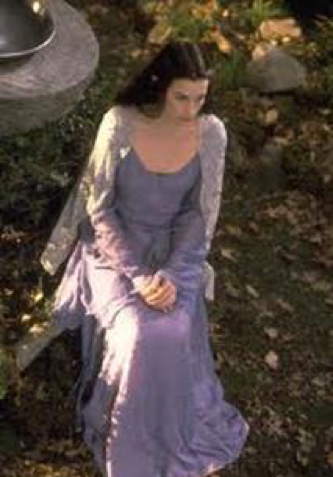
Another costume used in The Lord of the Rings
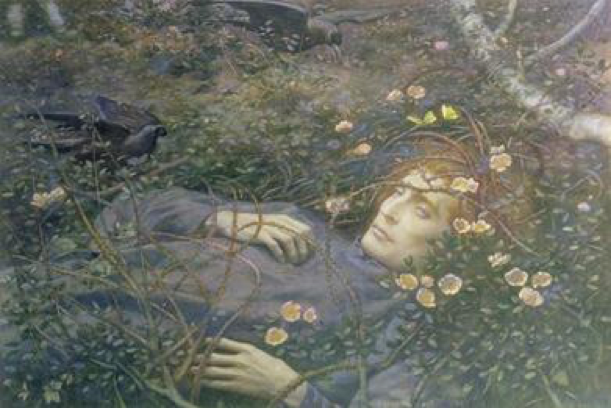
"Oh What's that in the Hollow" by Edward Robert Hughes.
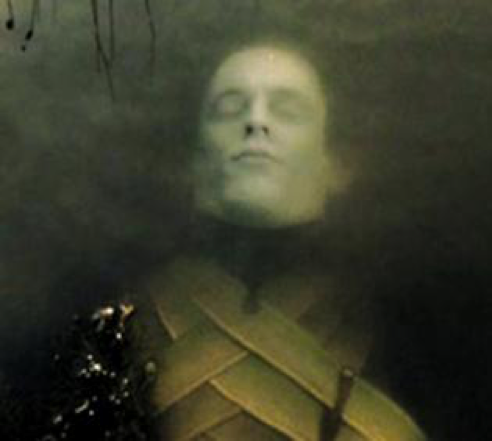
Resonant image from The Lord of the Rings
The point that I want to make here is this: Tolkien was not content to simply draw inspiration from high-brow operas. He took it from some of the most famous poets of his time, from ancient legends, from animated films, from great painters, and even from children's books, such as Wind in the Willows. (Compare "mad" Bilbo Baggins' journey from his underground home with that of Mole from Wind in the Willows. If you look closely, you'll see some interesting similarities.)
In short, Tolkien was like a sponge, seeking to draw resonance from tens of thousands of sources, and in doing so, create his own work that grew in strength and power.
That's how I suggest you try to imbue your work with resonance.
There are other ways to gain resonance in your work than to simply draw from other works of art, or to listen closely to the sounds of the names that you create.
A third way to use resonance is to discuss experiences that are fairly universal. Tolkien does this as well. At one point, as Frodo prepares to leave the Shire, he stops and thinks about how this is a grand step in his life.
Who hasn't done the same? I remember my first day of school, at age six, thinking about how important a step it was in life. Again when I left high school and left home, I was much like Frodo, taking one long, last look at my house before I drove away. Anyone who has gone to college or to fight a war understands how keen that emotion can be.
Similarly, Tolkien reminds us of plenty of other moments that each of us has felt in life. When reading of Frodo and Sam creeping into Mordor, you might recall Frodo peering up and seeing a star. Smitten by the beauty of it, Frodo suddenly takes heart and marches forward boldly. Who hasn't felt inspired by the beauty and grandeur of nature?
Or when Gandalf falls into the crevasse—who hasn't ached with grief when a mentor is suddenly stripped away? Tolkien had to have seen good men "fall" in combat during WWI, and I believe that when he wrote that scene, he was trying to dramatize for us how this all-too-common emotion feels.
So Tolkien touches us with wonder one moment when we meet the elves, or with delight as his Hobbits get a fine meal of mushrooms from a local farmer, or relief when Gandalf finally realizes the secret of how to open an ancient door into a mountain. He reminds us of the love we might have felt for a good animal one moment, and a longing to be home another. At every turn, we are reminded by the Hobbits of how frightening and dangerous larger people can be, an emotion that is overwhelming for children at times.
That's one of the keys to drawing and holding an audience—creating scenes that resonate with readers emotionally, that touch them deeply because they themselves have lived through a similar experience.
A similar thing can be done with themes. One great editor, Sol Stein, mentioned that by simply touching upon a universal truth, we as authors can create a bond with our reader. Thus, when Tolkien writes about the corrupting influence of the One Ring, it's something that we all connect with. Tolkien was undoubtedly familiar with Lord Acton's quote, "Power corrupts, and absolute power corrupts absolutely." Tolkien's dramatization of that theme is outstanding.
There are a number of other ways to write an epic, though, to try capture a picture of life. The Russian critic argued that in order to write an epic, to give readers the illusion that a book captured the whole life, the author had to use all of the various levels of language of his society. This makes sense in Russian, where a commoner, a merchant, and a lord had vastly different dialects, and one can see a master at this technique in a modern fantasy writer, Patrick Rothfuss, in his epic masterpiece The Name of the Wind.
This concept is similar to Chaucer's belief that by writing about people in various occupations—lord, knight, merchant, serf—he could try to capture all of life. After all, nothing marks a person's class as much as his language.
Other critics have sought to cover the various stages of life in order to create an epic—childhood, young love, courtship, the raising of a family, old age and death.
Certainly Tolkien uses each of these techniques to some degree. But more importantly, I believe that Tolkien was trying to capture a world of emotions in order to give his work epic scope.
For those of you who want to write epics, you might want to take note of what he did.
But there is another way that you can create resonance in your story—through resonance within the work itself, or "internal" resonance.
Bạn đang đọc truyện trên: AzTruyen.Top